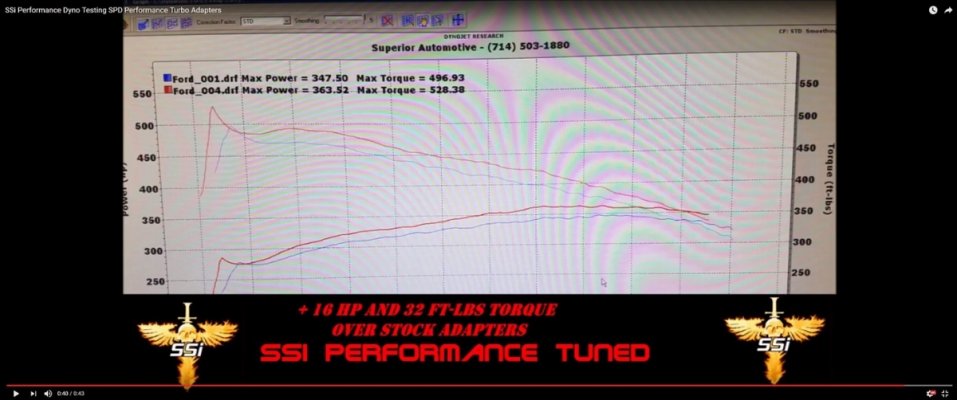Yes the logic makes sense. My hang up is still....
Let's say the stock adapter can flow 5cfm and the engine is pumping 3cfm. Going to an adapter that can flow 8cfm isn't going to allow any more gas to pass. It's just a bigger hole. For this to have proof of concept we have to assume that the stock adapter has insufficient capacity per minute of flow. It very well might, but what if it doesn't? Then it's just a bigger hole. I can't imagine you'd lose power, but I can imagine a scenario where it would do little or nothing too... just like a cat back. If it isn't a bottle neck... it isn't going to make more power even if it has the capacity to flow more.
You have your turbine wheel, which is connected to a shaft, which is connected to the compressor wheel. The turbine wheel is the half of the turbo that the exhaust gas drives. The compressor wheel is the half of the turbo that compresses the atmosphere into "boost" for the engine. The turbine wheel is driven by the pressure caused when the hot exhaust gas is expanded and cooled off across the turbine wheel. Pre turbine, the exhaust gas should ideally maintain high velocity and stay as hot as possible. As the exhaust gas cools and expands across the turbine wheel and exits the turbine housing, it cools significantly, slows down and becomes turbulent. It has to in order for the differential pressure to take place needed to force the turbine/shaft/compressor rotation. The greater the differential pressure, the greater the force turning the turbine. This cooled, slow, turbulent exhaust gas needs a place to go, and that's where your "larger turbo adaptor/downpipe/exhaust/no exhaust at all" theory is, for the
most part, accurate as it give that gas a place to go-away from the turbine. Any pressure lingering around at the turbine exit, reduces your differential pressure/drive force. The section of exhaust immediately after the turbo, and it's optimization, is the most crucial of the whole exhaust system.
Now all the above you may aready understand, but I felt it was necessary to cover before talking about what you said that caught my attention enough that I felt it needed addressed. The thought that if the engine moves 3cfm, the turbo adaptor can flow 5cfm, why do we need 8cfm bigger of a hole?? is flawed because it's based on the engine flowing a fixed rate. The engine isn't flowing at a fixed rate, even at set engine speeds, it has one (well two) things causing a significant variable in flow... the TURBOS! Allowing the greater pressure differential across the turbine, drives the compressor wheel harder-faster, therefore creating more flow rate (boost), or at least greater change in flow rate (anti-lag) through the engine. Now you need the 8cfm of flow hole action.
Now do the aftermarket adaptors actually do what they claim?? I have no idea one way or another. The bigger is better theory should apply-so yes they should work. But there are some schools of thought, or proof of concept, that some turbine efficiency is effected, or optimized, by the angle at which the exhaust gas exits (and its uniformity) by design. So the common "bigger is better" theory may not apply in this scenario and could actually hurt if angle was changed; although my bet is the aftermarket adaptors work as described and the factory size is due more so for emissions.
As for exhaust flow driving the turbo. It's been mentioned a few time in this thread that the exhaust flow helps drives the turbo and create boost too. Ehhh no. Not really, or we'd have a perpetual motion machine on our hands. Exhaust flow is the means that delivers and directs the heat for the turbine to eat.



